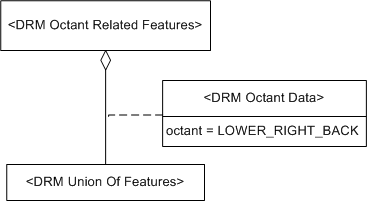Class Name: Octant Related Features
Subclasses
This DRM class is concrete and has no subclasses.
Definition
An instance of this DRM class specifies an aggregation of
<Feature Hierarchy> instances in
which each <Feature Hierarchy> component
represents an octant. The octant represented by a branch is
specified by the <Octant Data> link object
associated with that branch. The bounding region that the
<Feature Hierarchy> components occupy is
defined by the <Spatial Extent> component
of the <Octant Related Features>
instance.
Primary Page in DRM Diagram:
Secondary Pages in DRM Diagram:
This class appears on only one page of the DRM class diagram.
Example
Consider an aggregation that is represented in a transmittal by
an <Octant Related Features>
instance. The lower right back octant of the aggregation is a
<Union Of Features> instance aggregated by the
<Octant Related Features>
instance as depicted in Figure 34:

Figure 34 — <DRM Octant Related Features> example
FAQs
-
If an <Octant Related Features>
instance has less than eight components, why is the data being organized
under
an <Octant Related Features>
instance at all?
An <Octant Related Features>
instance is used when a DRM object in the hierarchy contains
spatial components that
occupy a certain octant. These octants might not contain
<Primitive Feature> instances,
which is why this class can have less than eight components.
-
Where is the <Spatial Extent> component?
An <Octant Related Features> instance
automatically has a <Spatial Extent> component,
because it is a <Feature Hierarchy> instance.
However, unlike other classes descended from
<Feature Hierarchy>,
<Octant Related Features> has a
constraint stating that the <Spatial Extent>
component is mandatory.
Constraints
Associated to (one-way) (inherited)
Associated by (one-way) (inherited)
Composed of (two-way) (inherited)
Composed of (two-way)
Composed of (two-way metadata) (inherited)
Component of (two-way) (inherited)
Notes
Associated to Notes
An association between two
<Feature Representation> instances
indicates that the environmental object(s) that they
represent have the semantic relationship indicated by
the <Base Association Data>
link object on the association relationship.
An association between a
<Geometry Hierarchy> instance and a
<Feature Representation> instance
indicates that the environmental object(s) that they
represent have the semantic relationship indicated by
the <Base Association Data>
link object on the association relationship.
An association between a
<Property Grid> instance and a
<Feature Representation> instance
indicates that the environmental object(s) represented by the
<Feature Representation> instance
and the <Property Grid> instance
(or some specific cell data within that
<Property Grid> instance) have the
semantic relationship indicated by the
<Base Association Data> link object
on the association relationship. Each associated
<Property Grid> instance indicates
whether the entire <Property Grid>
instance or only some specific cell data within it is participating
in the relationship in question.
Associated from Notes
An association between two
<Feature Representation> instances
indicates that the environmental object(s) that they
represent have the semantic relationship indicated by
the <Base Association Data>
link object on the association relationship.
An association between a
<Geometry Hierarchy> instance and a
<Feature Representation> instance
indicates that the environmental object(s) that they
represent have the semantic relationship indicated by
the <Base Association Data>
link object on the association relationship.
An association between a
<Property Grid> instance and a
<Feature Representation> instance
indicates that the environmental object(s) represented by the
<Feature Representation> instance
and the <Property Grid> instance
(or some specific cell data within that
<Property Grid> instance) have the
semantic relationship indicated by the
<Base Association Data> link object
on the association relationship. Each associated
<Property Grid> instance indicates
whether the entire <Property Grid>
instance or only some specific cell data within it is participating
in the relationship in question.
Composed of Notes
The <Image Mapping Function> components
support texture mapping information
for geometry that is to be derived from the
<Aggregate Feature> instance
by the consumer.
These <Image Mapping Function>
instances shall use <Image Anchor>
components to specify the mapping.
A <Presentation Domain> component is needed for
<Aggregate Feature> instances that are
significant only for a particular domain, such as radar.
Fields Notes
If the value of the
unique_descendants
field is SE_TRUE, each
descendant shall be unique in the sense that it shall
appear in only one branch of this aggregation.
Each descendant is a <Feature Representation> instance
within the component tree rooted at the
<Aggregate Feature> instance.
If unique_descendants
is SE_FALSE, at least one
<Feature Representation> instance
appears in more than one branch of the aggregation.
If the value of the
strict_organizing_principle
field is SE_TRUE, each
branch of this aggregation
strictly complies with the organizing principle for its
particular subclass. If this value is
SE_FALSE, at least
one branch does not strictly comply with the given
organizing principle. See the organizing principle constraint
for each specific subclass for details.
Prev: Octant Data.
Next: Octant Related Geometry.
Up:Index.
